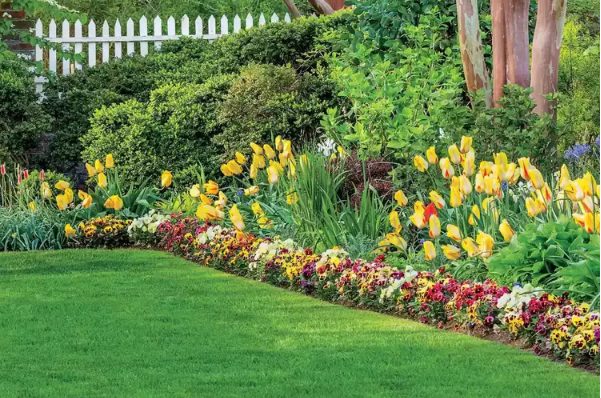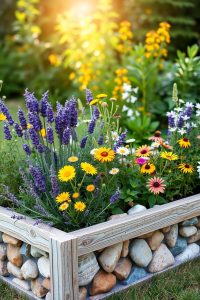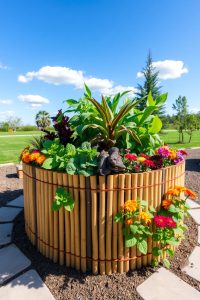
10 Raised Garden Edging Ideas That Add Style and Structure

Raised garden beds deserve more than just a basic border. The right edging adds structure, keeps soil in place, and gives your garden a clean, polished look.
From rustic wood to sleek metal or playful stone, each option brings its own charm to the space.
Well-chosen edges also help define planting areas and prevent weeds from creeping in. Some designs even double as seating or storage.
With so many creative and practical styles to explore, you can match the edging to your garden’s theme or your home’s exterior.
Whether you enjoy a modern backyard or a cozy cottage garden, these ideas bring function and beauty together.
This guide shares ten unique raised garden edging ideas to inspire your next garden project.
Each one adds a special touch while keeping your beds neat and tidy. Let’s dive into designs that work hard and look great all season long.
10 Raised Garden Edging Ideas
Raised garden beds help organize your outdoor space. But the edges around them often get overlooked. Good edging adds both beauty and strength.
It keeps the soil in place, stops weeds, and gives your garden a clean finish. It also makes your garden easier to maintain.
Some edging ideas use natural materials, while others have a modern touch. This post shares 10 raised garden edging ideas that are simple, creative, and fit many garden styles.
Let’s explore some easy, attractive ways to edge your raised garden beds.
1. Wooden Plank Edging

Wooden plank edging works great in almost any type of garden. It’s easy to install and gives your garden a neat, natural look.
You can use different types of wood like cedar, pine, or redwood. Cedar and redwood last longer because they fight rot better.
For a more polished design, sand the edges and paint or stain the planks. Dark stains give a bold look, while light colors feel softer and cozy.
Stack two or three planks to raise the bed higher. This makes gardening easier since you don’t have to bend as much.
Wood also blends well with flowers, herbs, and vegetables. Over time, it ages and turns silver-gray, which adds more character to your garden.
2. Brick Edging
Bricks bring strength and timeless charm to raised beds. You can arrange them in different styles to match your space.
Straight lines look clean, while curved rows feel more relaxed.
Brick edging also helps with water control. It keeps soil from washing out during heavy rain. For a stronger border, use mortar between the bricks, or lay them close together for a dry-fit look.
You can also get creative with brick color. Red bricks feel warm and classic. Gray or black bricks give a modern touch.
For small gardens, bricks make beds feel solid and secure without taking up much space.
3. Stone Edging

Stone edging gives your raised garden bed a natural and strong feel. You can use different kinds of stones like river rock, granite, or flagstone.
Each type offers a unique shape, texture, and color. Arrange stones in layers to build up height. This works well for sloped gardens or areas with poor soil.
Add small pebbles or gravel between stones to fill gaps and stop weeds. Stones do not need much care and last for years.
They stay cool in summer and blend beautifully with green plants, trees, and flowers. This edge style works especially well in cottage gardens or spaces that feel close to nature.
4. Metal Edging
Metal edging offers a sharp, modern look with clean lines. Steel, aluminum, and corten steel are common choices. Corten steel develops a rusty color that protects it from further damage.
This type of edging bends easily, so it fits curved beds and geometric shapes. It holds soil in place and gives your garden a structured, tidy look. Metal also helps prevent grass roots from sneaking into your beds.
Use thick steel for long-lasting strength. Anchor it with strong stakes to keep it from shifting. For a finished look, leave the top edge exposed or hide it under mulch or gravel.
5. Concrete Block Edging
Concrete blocks are strong and easy to stack, making them perfect for building tall raised beds. These blocks don’t rot and can handle heavy soil. You can lay them without mortar for quick changes later.
Each block has holes that you can fill with soil to grow extra herbs or flowers. That means more growing space in the same area. Add color by painting the outside or planting flowers in the open ends.
Concrete edging also works well in areas with poor drainage. The blocks allow good airflow and water movement, keeping roots happy and healthy.
6. Bamboo Edging

Bamboo gives your garden a calm, peaceful look. It’s light but strong and works well for small and large raised beds. Bamboo also grows fast, so it’s an eco-friendly choice.
Cut bamboo into short pieces and place them upright for a fence-like border. Tie them with garden wire or natural twine. For a more solid look, use bamboo panels or rolls.
This edging matches well with tropical plants, water features, or Asian-style gardens. Bamboo can last a long time if sealed and kept off wet soil. It adds a soft, natural look that many gardeners love.
7. Log Edging
Log edging feels like it came straight from the forest. It brings a cozy, natural style to your garden. Use thick branches or cut logs to make a low fence.
Logs can be placed vertically for a rounded look or laid flat for a strong border. Logs hold soil well and give insects like beetles and worms a place to live, which helps your garden.
Cut them to equal height for a smooth finish, or leave them uneven for a more wild look.
Seal the logs with plant-safe products to protect them from rot. This type of edging pairs well with mulch paths and native plants.
8. Recycled Pallet Edging

Pallet wood is a smart way to edge your garden without spending much. Many stores give away old pallets, so this idea saves money and reduces waste.
Take the pallets apart and cut the boards to size. Nail or screw them around your raised bed. You can stain the wood or paint it in fun colors to match your garden theme.
Recycled wood adds charm and shows off your creativity. This idea fits best in DIY-style gardens or relaxed, casual spaces. Just make sure the pallet wood is not treated with chemicals harmful to plants.
9. Corrugated Metal Edging
Corrugated metal adds shine and texture. It reflects sunlight, which warms your soil and helps plants grow. These metal sheets also resist rust, especially if coated or galvanized.
Cut the metal sheets to match your bed’s size. Fasten them to wooden or metal posts at each corner. This creates a strong frame that lasts through all seasons.
Corrugated edging works well for vegetable gardens, herb beds, or modern yards. Mix it with wood for a more rustic look or use just metal for a clean, industrial feel. It’s also easy to wash and keeps weeds out.
10. Decorative Tile or Mosaic Edging

Mosaic tiles turn a basic raised bed into a piece of art. Use broken dishes, old tiles, or colored glass to make your design. Glue them onto a small concrete wall or wooden frame around your bed.
Pick a color theme that matches your flowers or the rest of your garden. You can make simple shapes or detailed patterns. This edge idea is great for adding personality and color to your outdoor space.
Make sure to use weather-safe glue and grout. Once set, the tiles won’t move or fade. This edging works well for flower beds, kid-friendly gardens, or spaces where you want something special.
FAQs
What is the easiest material to use for garden edging?
Wood and concrete blocks are the easiest for most people. They don’t need special tools and are simple to install.
Which edging lasts the longest?
Stone and metal last the longest. They resist weather and don’t break down easily.
Can I paint or decorate the edging?
Yes. You can paint wood, bricks, concrete blocks, and even metal. Just use outdoor paint or weather-safe sealers.
Is raised garden edging good for drainage?
Yes. Raised beds with edging allow water to flow better, especially if the edging doesn’t block the bottom of the bed.
How do I stop weeds from growing through the edge?
Use landscape fabric or mulch around the edge. Some edges like metal or stone create a solid barrier that stops most weeds.
Do I need to dig before installing edging?
In most cases, yes. Digging a small trench helps hold the edging in place and keeps it from shifting over time.
What tools do I need to install edging?
Basic tools like a hammer, shovel, drill, or saw work for most edging types. Some materials like metal may need tin snips or clamps.
Can I mix two types of edging?
Yes. Mixing styles can look creative and unique. Try wood and metal or stone and tile for different looks.
Is edging safe around kids and pets?
Yes, if installed correctly. Avoid sharp edges and always secure the materials well to avoid tipping.
Will edging help protect my plants?
Yes. It keeps soil in place, stops weeds, and keeps pests like grass and creeping vines away from your plants.
Conclusion
Raised garden edging does more than just frame your plants. It gives structure, protects soil, and adds style to your space.
Simple materials like wood, bricks, or stone make a big difference. Bold choices like metal or tile can turn your garden into a standout feature.
Try one of these edging ideas to refresh your garden bed. Whether you want something natural, modern, or creative,
the right edge will improve both the look and function of your garden. Start small, use what fits your space, and enjoy the beauty a well-edged garden brings.
